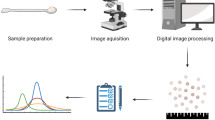Abstract
Image analysis techniques have been applied and shown to be a valuable tool in nuclear forensics analysis. The interlaboratory exercise reported here has tested quantitative and qualitative approaches for characterizing nuclear materials. Particle size, surface features and morphology descriptions were compared by four laboratories on a common image set generated by Scanning Electron Microscopy and Digital Light Microscopy. Quantitative analysis of the image sets through the Morphological Analysis for MAterials software highlighted the strength of image analysis, but also that the application of the software alone can introduce significant bias in the analysis. Qualitative morphology descriptions following the process outlined by Tamasi et al. (J Radioanal Nuclear Chem 307:1611–1619, 2015) were compared with a discussion on the robustness and reproducibility of the results. Future work should continue to focus on proficiency and standardization of image analysis through continued exercises within the extended nuclear forensics community.







Similar content being viewed by others
References
Tamasi AL, Leigh JC, Eley C, Porter RB, Pugmire DL, Ross AR, Ruggiero CE (2015) A Lexicon for Consistent Description of Material Images for Nuclear Forensics. Journal of Radioanalytical and Nuclear Chemistry 307(3):1611–1619. https://doi.org/10.1007/s10967-015-4455-0
Varga Z, Wallenius M, Krachler M, Rauff-Nisthar N, Fongaro L, Knott A, Nicholl A, Mayer K (2022) Trends and Perspectives in Nuclear Forensic Science. TrAC, Trends in Analytical Chemistry 146:116503. https://doi.org/10.1016/j.trac.2021.116503
Porter, R.; Ruggiero, C.; Hush, D.; Harvey, N.; Kelly, P.; Scoggins, W.; Tandon, L. (2011) Interactive image quantification tools in nuclear material forensics, IS&T/SPIE Electronic Imaging, 2011, San Francisco Airport, California, United StatesP
Ruggiero CE, Ross A, Porter R (2015) Segmentation and Learning in the Quantitative Analysis of Microscopy Images. SPIE Proceedings. https://doi.org/10.1117/12.2083776
Sentz, K.; Schaffer, K.; Porter, R.; Ruggiero, C.; (2016) MAMA User Guide v3, Los Alamos National Laboratory.
Ly C, Olsen AM, Schwerdt IJ, Porter R, Sentz K, McDonald LW, Tasdizen T (2019) A New Approach for Quantifying Morphological Features of U3O8 for Nuclear Forensics Using a Deep Learning Model. J Nucl Mater 517:128
Olsen A, Schwerdt M, Jolley I, Halverson A, Richards N, McDonald B (2019) A response surface model of morphological changes in UO2 and U3O8 following high temperature aging. Radiochim Acta 107:449
Schwerdt I, Brenkmann J, Martinson A, Albrecht S, Heffernan BD, Klosterman S, Kirkham MR et al (2018) Nuclear Proliferomics: A New Field of Study to Identify Signatures of Nuclear Materials as Demonstrated on Alpha-UO3. Talanta 186:433
McDonald IVL, Nizinski C (2020) Effects of Process History on the Surface Morphology of Uranium Ore Concentrates Extracted From Ore. Minerals Engineering. https://doi.org/10.1021/scimeetings.0c06591
Olsen AM et al (2017) Quantifying Morphological Features of α-u3O8 with Image Analysis for Nuclear Forensics. Anal Chem 89(5):3177–3183. https://doi.org/10.1021/acs.analchem.6b05020
Schwerdt IJ et al (2018) Nuclear Forensics Investigation of Morphological Signatures in the Thermal Decomposition of Uranyl Peroxide. Talanta 176:284–292. https://doi.org/10.1016/j.talanta.2017.08.020
Said M, Marks NE, Dai Z, Lindvall RE (2012) Qualitative Assessment of Uranium Ore Concentrates and Related Materials Using Scanning Electron Microscopy. Journal of Radioanalytical and Nuclear Chemistry. https://doi.org/10.1007/s10967-022-08605-6
Marchetti M, Fongaro L, Bulgheroni A, Wallenius M, Mayer K (2022) Classification of Uranium Ore Concentrates Applying Support Vector Machine to Spectrophotometric and Textural Features. Applied Geochemistry 146:105443. https://doi.org/10.1016/j.apgeochem.2022.105443
Hanson AB, Nizinski CA, McDonald IVL (2021) Effect of Diel Cycling Temperature, Relative Humidity, and Synthetic Route on the Surface Morphology and Hydrolysis of α-u3O8. ACS Omega 6(28):18426–18433. https://doi.org/10.1021/acsomega.1c02487
Hanson AB, Schwerdt IJ, Nizinski CA, Lee RN, Mecham NJ, Abbott EC, Heffernan S et al (2021) Impact of Controlled Storage Conditions on the Hydrolysis and Surface Morphology of Amorphous-UO3. ACS Omega 6(12):8605–8615. https://doi.org/10.1021/acsomega.1c00435
Schwartz, D.S., L. Tandon. 2017 Uncertainty in the Use of Mama Software to Measure Particle Morphological Parameters from Sem Images. https://doi.org/10.2172/1361474
Jillavenkatesa, A., S.J. Dapkunas, L.S.H. Lum. 2001 Particle Size Characterisation–National Insitute of Standards and Technology of Special Publication 960–1. Washington, DC: U.S. Government Printing Office.
Gaschen, B. K., et al. 2016. LA-UR-16–25116. MAMA User Guide v2.0.1.
Croarkin, C., P. Tobias. 2002 Engineering statistics handbook. Washington, D.C: NIST iTL.
Schwerdt, I.J., A.B. Hanson, R.B. Porter, K. Sentz. 2021. Morphological and Particle Size (MaPS) Image Round Robin Exercise LA-UR-22–22359.
Burr Tom, Schwerdt Ian, Sentz Kari, McDonald Luther, Wilkerson Marianne (2021) Overview of Algorithms for Using Particle Morphology in Pre-Detonation Nuclear Forensics. Algorithms 14(12):340. https://doi.org/10.3390/a14120340
Acknowledgements
Los Alamos National Laboratory’s and Pacific Northwest National Laboratory's participation in the interlaboratory comparison were supported by the U.S. Department of Energy National Nuclear Security Administration Office of Defense Nuclear Nonproliferation Research and Development under grants nos. LA21-ML-MorphologySignature-P86-NTNF1b and PL21-ML-Pu_Process_Signatures_for_NF-FRD1Bb, respectively. Lawrence Livermore National Laboratory’s participation in the interlaboratory comparison were supported under the auspices of the U.S. Department of Energy under Contract DE-AC52-07NA27344. Lawrence Livermore National Laboratory’s is supported by the U.S. Department of Energy National Nuclear Security Office of Nuclear Smuggling Detection and Deterrence. LLNL-JRNL-860159.
Author information
Authors and Affiliations
Corresponding author
Ethics declarations
Conflict of interest
The authors declare no financial or conflicts of interest.
Additional information
Publisher's Note
Springer Nature remains neutral with regard to jurisdictional claims in published maps and institutional affiliations.
Rights and permissions
About this article
Cite this article
Dunn, S.A., Schwerdt, I.J., Meier, D.E. et al. Morphology and particle size (MaPS) exercise: testing the applications of image analysis and morphology descriptions for nuclear forensics. J Radioanal Nucl Chem 333, 2163–2181 (2024). https://doi.org/10.1007/s10967-024-09431-8
Received:
Accepted:
Published:
Issue Date:
DOI: https://doi.org/10.1007/s10967-024-09431-8














